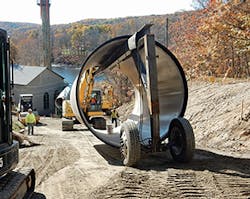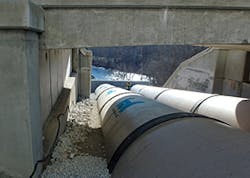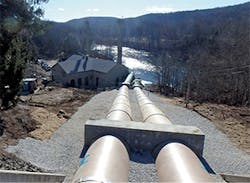In the early 1900s, the New Milford Power Company successfully completed the first commercially viable hydroelectric power plant on the Housatonic River in Connecticut. The project, Bulls Bridge Development, broke ground in the spring of 1902 and was in operation by 1903. Bulls Bridge was named after the Bull family that had lived in the area for generations.
The Bulls Bridge Power Plant, now owned by FirstLight Power Resources, is part of a five-station hydroelectric operation along the Housatonic River, which includes the Falls Village plant in Canaan, the Rocky River plant in New Milford, the Shepaug plant in Southbury, and the Stevenson plant in Monroe.
The Bulls Bridge Power Plant generates up to 8.4 megawatts as a run-of-the-river hydroelectric facility with a discharge capacity of 1,250 cubic feet per second (cfs). The facility diverts a portion of the river flow upstream of the main dam into a 2.5-mile long power canal leading to the forebay gatehouse and the recently replaced penstocks. The original 420-foot long, 13-foot and 8-foot diameter steel penstocks dropped 98 feet from the forebay to the powerhouse. The plant still generates power with the six original horizontal, double-runner Francis turbines.
Each year since 2013, the aging Bulls Bridge penstock had to be dewatered, inspected, and repaired as necessary. The penstocks were exhibiting deformation and corrosion at the saddle supports. In 2013 and 2014, numerous metal plate patches and weld repairs were required to mend leaks on the 13- and 8-foot diameter penstocks, but reliability concerns led to need for rehabilitation or replacement of the hundred-year-old penstocks. Gomez and Sullivan Engineers of Utica, NY, evaluated the alternatives for replacement or rehabilitation of the steel penstocks. Four alternative solutions were developed and evaluated:
- Replace the existing 13-foot diameter
- Replace both penstocks with a single 14-foot by 14-foot cast-in-place concrete box type penstock or a single 15-foot diameter steel penstock
- Replace both penstocks with two 10-foot diameter fiberglass reinforced (FRP) penstocks
- Rehabilitate the existing penstocks and foundations
The penstocks were replaced between September 2015 and January 2016 with 10-foot diameter centrifugally cast, fiberglass reinforced, polymer mortar (CCFRPM) pipe. Hobas Pipe USA manufactured 600 feet of 10-foot (120-inch) CCFRPM pipe for this replacement project.
After FirstLight selected FRP, they had to choose between Hobas and another option. FirstLight’s experience with Hobas on the Rocky River Penstock had much to do with it. The selection criteria included: a quality control/quality assurance program, uniformity of product, coupling sealing surface, assembly technique, joint testing, interior and exterior smooth finish, domestic manufacturing facility, proven at large diameters and wall thickness, and engineering technical assistance.
Installation posed its own challenges. The steep job site was located in a remote area with a section under an existing highway bridge with low overhead clearance. It was also necessary to construct a temporary road and crane pad to access the penstock replacement area from midway along its route from the forebay to the powerhouse.
An ingenious onsite transportation device used to install the pipe under the bridge was designed by the installation contractor, Bancroft Contracting Corporation of South Paris, ME. “The rig involved a long I-beam connected to a column,” explains Sawyer. “The column was composed of two hollow steel square tubes with one sliding inside the other and held in place with steel pins. Wheels were attached to the bottom of the column. The end of the beam not connected to the column was attached to the arm of an excavator, which could then drive the rig through a section of pipe and extend the column to lift the pipe off the ground. Then the rig was driven up to an installed section of pipe, and the column could be lowered to drive the rig into the installed pipe and butt the new section of pipe against the installed section.”
The new penstocks were partially buried two feet above the spring line, utilizing no cradles for support to optimize installation cost. The fill material was placed to about two feet above the pipe centerline, leaving three feet exposed. The CCFRPM pipe was designed and manufactured with an operating pressure of 50 pounds per square inch (psi) to accommodate the operating pressure of the line. The penstock was put into service in January of 2016.


